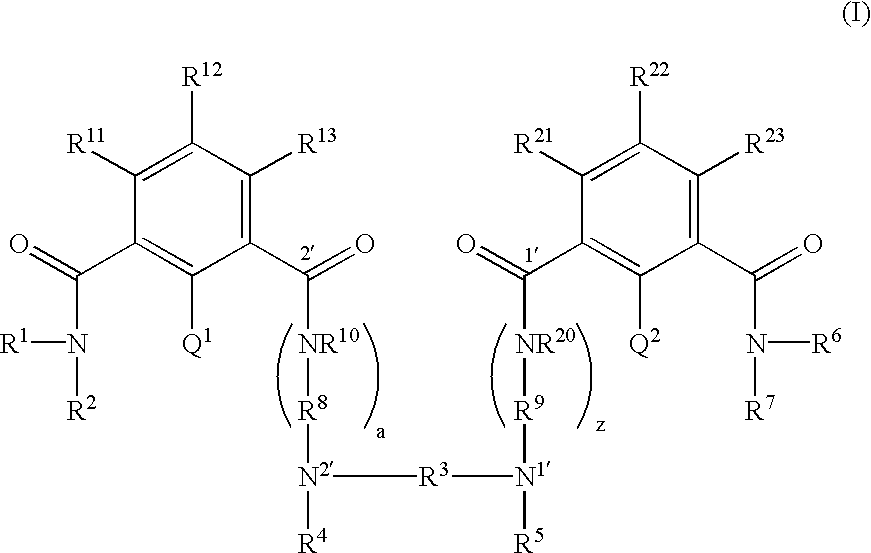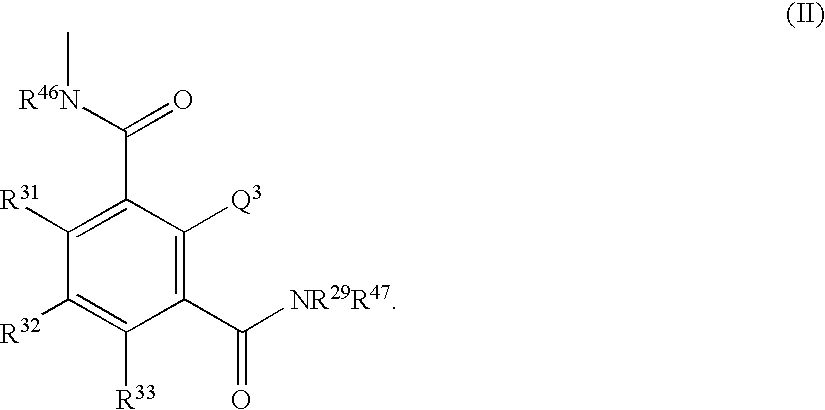Phthalamide-lanthanide complexes for use as luminescent markers
a technology of phthalamidelanthanide and complexes, which is applied in the field of phthalamidelanthanide complexes for luminescent markers, can solve the problems of label washing, high cost, and inability to achieve fluorescence development, and achieves improved fluorimetric instrumentation, increased attainable sensitivities, and the effect of allowing quantitative analysis
- Summary
- Abstract
- Description
- Claims
- Application Information
AI Technical Summary
Benefits of technology
Problems solved by technology
Method used
Image
Examples
example 1
[0384] Example 1 illustrates the synthesis of exemplary ligands of the invention and the formation of their metal complexes. The synthetic scheme for the compounds of Example 1 is set forth in FIG. 1.
[0385] 1.1 Materials and Methods
[0386] Unless otherwise noted, starting materials were obtained from commercial suppliers and used without further purification. Flash column chromatography was performed using Merck silica gel 40-70 mesh. Microanalyses were performed by the Microanalytical Services Laboratory, College of Chemistry, University of California, Berkeley. Mass spectra were recorded at the Mass Spectrometry Laboratory, College of Chemistry, University of California, Berkeley. .sup.1H and .sup.13C NMR spectra were recorded on an AMX 300 or AMX 400 Bruker superconducting Fourier transform spectrometer or on a DRX 500 Brucker superconducting digital spectrometer. Infrared spectra were measured using a Nicolet Magna IR 550 Fourier transform spectrometer. The UV / Visible spectra wer...
example 2
[0402] Example 2 details the x-ray structure determination of exemplary compounds of the invention. Molecular models based on the x-ray crystallographic data are set forth in FIG. 4 and FIG. 5.
[0403] 2.1 X-ray Data Collection, Structure Solutions, and Refinement.
[0404] All X-ray structure data sets were collected on a Siemens SMART Area Detector diffractometer (SMART, Area-Detector Software Package; Siemens Industrial Automation, Inc.: Madison, 1994). Crystals were mounted on quartz capillaries in Paratone oil and were cooled in a nitrogen stream on the diffractometer. Peak integrations were performed using Siemens SAINT software package (SAINT, SAX Area-Detector Integration Program v. 4.024; Siemens Industrial Automation, Inc.: Madison, 1994). Space group determinations were done by the software XPREP. The structures were solved by direct methods and refined using the SHELXTL software package (PC version, SHELXTL, Crystal Structure Analysis Determination Package; Siemens Industrial...
example 3
[0407] Example 3 details the spectrophotometric titration of exemplary compounds of the invention.
[0408] 3.1 Spectrophotometric Titrations
[0409] Batch titration samples were prepared in Millipore purified water with MES buffer, 0.1 M KCl, adjusted to pH=5.78 with KOH. The samples were incubated at 37.degree. C. for 15 hours before measurement to ensure thermodynamic equilibrium had been reached. The ligand concentration was 2.32.times.10.sup.-5 M for all samples and the EuCl.sub.3 was titrated from 0 to 2.2 equivalents. The spectra were recorded on a double-beam Perkin-Elmer Lambda 9 UV-Visible spectrophotometer in 1.0 cm quartz Suprasil cell. The samples were kept at a constant temperature of 25.0.+-.0.2.degree. C. using a Neslab RTE-111 water bath. The treatment of the data was performed with the using the software package SPECFIT 2.10..sup.86.1.
[0410] 3.2 Results
[0411] A batch titration of bicapped TRENSAM with Eu.sup.3+ was performed in order to evaluate the solution behavior an...
PUM
| Property | Measurement | Unit |
|---|---|---|
| molecular weight | aaaaa | aaaaa |
| molecular weight | aaaaa | aaaaa |
| wavelength range | aaaaa | aaaaa |
Abstract
Description
Claims
Application Information
 Login to View More
Login to View More - R&D
- Intellectual Property
- Life Sciences
- Materials
- Tech Scout
- Unparalleled Data Quality
- Higher Quality Content
- 60% Fewer Hallucinations
Browse by: Latest US Patents, China's latest patents, Technical Efficacy Thesaurus, Application Domain, Technology Topic, Popular Technical Reports.
© 2025 PatSnap. All rights reserved.Legal|Privacy policy|Modern Slavery Act Transparency Statement|Sitemap|About US| Contact US: help@patsnap.com



